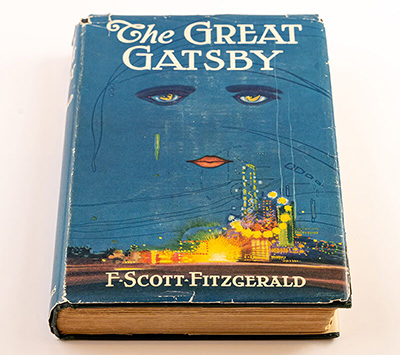I was recently at a rare book fair, which was quite fascinating. People, for a great variety of reasons, wish to own first editions of books. A mix of compulsion, obsession, and, to be sure, a great love of books, was on display.
Years ago, I embarked upon a search for old children’s books, haunting flea markets on an almost weekly basis. The books I found — and I found more than three thousand — were never expensive, never more than one or two dollars. This was before children’s books became collectible.
At any rate, at some point, I stopped searching for them and simultaneously had no place to keep them. In the end, I gave them all to the library at the University of Connecticut, which was building a research collection of children’s books. They are still there.
 But the books and ephemera at this fair were about a different world. I am not sure I would be willing to pay $250,000.00 for the first edition (with mint dust jacket) for Fitzgerald’s The Great Gatsby but apparently, there are people who can, and will make such a purchase. A letter written by George Washington (the ink faded) could be bought for $15,000.
But the books and ephemera at this fair were about a different world. I am not sure I would be willing to pay $250,000.00 for the first edition (with mint dust jacket) for Fitzgerald’s The Great Gatsby but apparently, there are people who can, and will make such a purchase. A letter written by George Washington (the ink faded) could be bought for $15,000.
And I was fascinated by the man who was a lawyer by day, but a major collector of Mark Twain books, and the memorabilia that pertained to the TV series Star Trek.
I did learn that people who collect books are full of stories about books. It was great fun to hear them.
I also sat in on a panel discussion titled, “The Dark Side of Book Collecting.” This was a talk by four collectors that dealt with book thefts, forgeries, and fakeries of all kinds in this rare book collecting world. I found it quite fascinating. It was like listening to four detectives talk about their favorite cases.
My favorite part of the discussion was about “Frankenstein Books,” a term I had never heard before.
What are “Frankenstein Books?” These are books that have been altered, marked, notated, restitched, or mutilated by their owners, not with evil intent, but just the opposite, with excessive love. It might be a book with notes in the margin, as in “I love this passage,” or “This statement is terribly wrong.” It might be a book that was converted into a scrapbook. In my collecting days, I used to find books that contained pressed flowers or four-leaf clovers. Unusual bookmarkers. Or even letters. All these Frankenstein Books reveal something, not so much about the books, but the people who owned them.
My own favorite Frankenstein Book was a 19th-century children’s book I once found that contained two short stories. One was about a young woman who marries a poor man, and the consequences of that marriage. The other story was about another young lady who marries a rich man and the consequences of that marriage.
But—on the flyleaf of that book was a handwritten message. As I remember it read something like:
“Dear Molly,
By the time you are old enough to read this book, I will have been long gone. But when you read this book, I hope you follow the wise advice my favorite story offers. I did.
Your Loving Grandmother…..”
But “Grandmother” never indicated which story was to be followed.
2 thoughts on “Frankenstein Books”
What was the name of the book? And which story do you think should be followed?
Though I’ve long since dropped the habit, when I was younger I went through a phase in which I’d add doodles and scribbles to book margins documenting my reactions to the text. (In fact, I was encouraged to do so by some of my instructors at the time.) My copies of the *Poppy* books (the first four—up to *Ereth’s Birthday*) were among those that received this treatment.